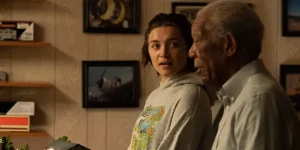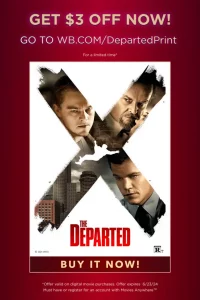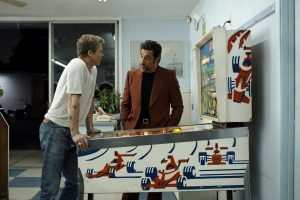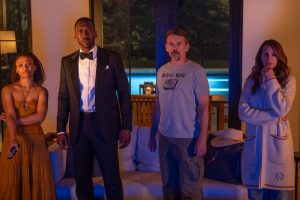
The story of World Championship Wrestling is one of an amazing rise but then a tragic fall that was hard to watch. While the American wrestling promotion spent much of its early days as second best, WCW figured itself out at a time when the World Wrestling Federation was destroying itself in the ’90s. WCW rose up and became what seemed like an unstoppable force before tripping on its own success while WWF recovered from its mistakes and regained traction. Having lost all that momentum, WCW did itself no favors by spending the next several years making every single bad decision possible. They absolutely could not get a win if they tried.
Now the dead promotion is considered a cautionary tale and a pile-on for jokes about the Shockmaster, David Arquette, the Fingerpoke of Doom, Hulk Hogan being humped by a giant mummy, the fumbling of Steve Austin, Judy Bagwell on a forklift, and so many other things.
That said, WCW stood as tall as it did for a reason. It was an alternative to WWF and for a time succeeded in ways WWF did not. There were just certain things WCW did a whole lot better than its competition…
15. Big Van Vader
During the first half of the ’90s, Big Van Vader was WCW’s go-to monster. Massive, strong, and agile, Vader was a threat who could run through Sting in a surprise squash match and turn a title defense against Ric Flair into a potential funeral. Vader was a top threat whose train got derailed once Hulk Hogan looked in his direction. But that was okay, because then he got signed to WWF!
Vader looked threatening in his opening months at WWF, and even got to be the man who laid out the Ultimate Warrior in Warrior’s final televised WWF appearance as an active wrestler. But then he crossed paths with a vindictive Shawn Michaels and Vader’s career started to roll downhill. By the end of his run at WWF, he was moping in post-match interviews about how he was “nothing but a big, fat piece of shit.”
14. Ernest “The Cat” Miller
In terms of in-ring skill, Ernest Miller was on the bottom rung. Luckily, he had more than enough charisma to make up for it. When Chris Jericho left WCW, Miller was the closest thing we had to fill the void of a loudmouth who would talk shit during in-ring promo segments and keep things entertaining. He was the three-time karate champion, damn it! He referred to Stevie Ray as “Yogi Bear” for some reason! There was a whole feud built on bored members of the nWo telling Scott Norton, “Hey, the Cat’s in the ring making fun of you!” just to see what happened.
(The Cat getting beat up is what happened.)
The Cat did eventually make his way to WWE long after the WCW Invasion, but did not last long. He’s only remembered for a very brief comedy dancing spot at the 2004 Royal Rumble (which he repeated on SmackDown days later) and for having a theme song (“Somebody Call My Momma!”) that would later be reused by Brodus Clay and Xavier Woods. Does that mean that different mothers are being called or is this a stealth reveal that those three wrestlers are half-brothers? We can only speculate.
13. The Lethal Lottery
WCW’s specialty matches were admittedly a mixed bag. On one hand, you had WarGames, which WWE eventually adapted years later. On the other hand, World War III was a high concept take on battle royals that was too busy to be fun. The Lethal Lottery may not come to mind when it comes to WCW’s greatest moments, but the concept was the closest thing WCW had to the Royal Rumble. It was a big event that made good use of the promotion’s diverse roster and created unique dynamics under the façade of randomness.
The idea was that wrestlers would be randomly paired together via lottery system. While some promotions have used that setup for tag tournaments, WCW did it best by having the winning teams take part in a main event battle royal. Either way, it’s a shame WWE never picked up this idea. At best, they did it backwards with the WrestleMania XV pre-show battle royal where the final two went on to challenge for the tag titles. Even then, it had potential and they did nothing with it.
12. Working with Other Promotions
WCW had a long relationship with New Japan Pro Wrestling, which was for the most part a great collaboration. They put on crossover shows like the WCW/New Japan Supershow series and the controversial Collision in Korea. The promotions also regularly exchanged talent, which is how we got Keiji Muto’s legendary Great Muta persona. Hell, these crossovers even led to the creation of an nWo Japan!
Sadly, this relationship died a horrible death once Vince Russo joined WCW and injected everything with his brand of awful. Still, this is a step above WWE’s history with other promotions. At best, WWE experimented with some quick crossover stuff, such as the ECW-laced episode of Raw in 1997 and 1990’s WWF/AJPW/NJPW Wrestling Summit. If a promotion was lucky, they received a passing spotlight from the WWE. The ones that come to mind are Genichiro Tenryu’s appearances, Jushin Liger in NXT, and whenever a TNA Women’s Champion shows up in the Royal Rumble. At worst, we got WWF’s collaboration with NWA, which didn’t have a prayer at success and quietly died on the vine. No wonder the WWF vs. WCW feud ended so badly.
11. Marc Mero
During his five years at WCW, Marc Mero was a solid staple of the midcard under his Johnny B. Badd persona, the kind of guy who would constantly open the show because he was so good at getting the crowd riled up. Whether a heel or a face, the Little Richard knockoff was endearing and had the right mix of in-ring ability and character. Maybe it was a gimmick that was never going to get him to the top, but he had a strong run that earned him three reigns as TV Champion.
Mero then went to WWF at a time when the promotion needed new talent. Unfortunately, he couldn’t take the Johnny B. Badd gimmick with him from WCW. He was still pushed aggressively by the WWF in the beginning, including as the new Intercontinental Champion, but a torn ACL eventually made him a shell of the performer he once was. Adding to that, his wife and valet Sable became so much more popular at WWE that Mero – now with a jealous and abusive persona – had to eat a loss or two to her. That was about it for his WWF career.
10. Bryan Clark
In 1993, WWF signed Bryan Clark and gave him the gimmick of Adam Bomb, a ’90s-as-hell radioactive giant. He was very agile for his size and had a cool look, ridiculous as it was. The promotion just didn’t really know what to do with him other than have him throw Nerf footballs to the crowd. And so, he left and went to WCW, where he became Wrath, a member of the Glacier “Blood Runs Cold” corner of WCW until that petered out. But from the ashes, he rose once again to become an unbeatable force until unceremoniously losing to Kevin Nash as part of Nash’s quest to end Goldberg’s winning streak.
But Clark wasn’t done. He found success in WCW’s latter years by teaming up with Brian Adams to form KroniK, which was a cheap knockoff of WWF’s APA team, but with weed jokes instead of all the alcohol consumption. That said, they were a fun and dominant tag team during the end days of WCW. That unfortunately did not translate when they reappeared at WWF to face the Brothers of Destruction at Unforgiven 2001. The match was so terrible that it killed KroniK and Clark never saw a WWE ring ever again.
9. Sting
Sting was WCW’s ace, though that got muddied once Hogan showed up. Even then, he eventually evolved into his Crow persona and became the badass would-be savior against the New World Order. Things didn’t always work out, such as when Starrcade ’97 ended up being an utter disaster due to behind-the-scenes sabotage, but no matter how lousy things got for Sting at WCW, it was always going to be head and shoulders above what WWE did with the character years later.
The entire Sting vs. Triple H feud was outright disrespectful. Despite “The Vigilante” Sting (or a picture of Sting) explaining that he was trying to counter Triple H’s abuse of power, the Authority and the commentators insisted that the whole thing was sour grapes over WCW dying. Then their WrestleMania match doubled down on this further, while including the nWo inexplicably helping Sting because…WCW? It was an awful exhibition and the less said about the rest of his run, the better. At least he got to end his career on a better note at AEW.
8. Raven
Raven at WCW was just a lesser version of his ECW persona, but there was still plenty of spark. He was a grimy, grungy borderline cult leader who hated himself, his minions, and his enemies to varying degrees. While the nWo dominated most WCW main events of the ’90s era, we had Raven’s Flock as a haven for the midcarders. That stable added a fresh coat of paint to a lot of the roster, including Perry Saturn, who is an honorable mention for this list. Even when the Flock ran its course and Raven became a snarky rich kid, he still had it.
He left the company to spend some time in ECW before heading to WWF pre-Invasion. But outside of a tag team with Taz and a run as Hardcore Champion, there just wasn’t much to WWF Raven. According to Raven himself, his close “drinking buddy” friendship with Vince McMahon’s son, Shane, is what killed his WWE career. Whether true or not, his career at WWF fizzled and he found a new lease at TNA and ROH.
7. Hulk Hogan vs. Ric Flair
In late ’91/early ’92, the ball was in WWF’s court. They had Ric Flair on the roster and immediately started building towards a showdown with Hulk Hogan, the biggest dream match possible at the time. It was wrestling’s version of Godzilla vs. King Kong, John Wayne vs. Clint Eastwood. Even though WWF initially set the match for WrestleMania VIII, it ultimately didn’t happen. Rumor has it that the match simply didn’t land very well at house shows. Others say that the reason it never happened was that Sid Justice had a WrestleMania main event in his contract. Either way, WWF went with Flair vs. Randy Savage and Hogan vs. Sid. Hogan then went on vacation and Flair was gone before Hogan returned.
WCW had no such issue hosting the match. The promotion hyped up Hogan’s debut on the basis that it would immediately lead to Hogan vs. Flair for the title at Bash at the Beach 94. The result was a solid main event that did great business. The two continued to feud on and off for the next six years. Unfortunately, WCW drove the rivalry into the ground, and it led to the infamous Yapapi Strap Match, but the existence of Hogan’s promos from that feud are gold in their own right. THE STRAPATION, BROTHER!
6. The Cruiserweight Division
This one should go without saying. WCW had lots of ideas for how to differentiate itself from WWF before the latter adapted to each new strategy. Putting higher-profile matches on the Monday show? Moving the product in an edgier direction? Introducing a heel authority figure? Blurring the lines between reality and fiction? WWF figured out their own take on all of those WCW initiatives in time. Highlighting smaller wrestlers, specifically luchadores, and showcasing them in exciting gravity-defying matches full of insane acrobatics off the top rope? WCW made that work really well for a good stretch. WWF…? Not so much.
WWF introduced the Light Heavyweight division, which lasted longer than you’d think, but considering Gillberg held the title for over a year during the Monday Night Wars, it’s hard to argue they really tried that hard. They did recruit some masked Mexican wrestling talent and had that one Royal Rumble where they threw in some luchadores to fill up the thin roster. The company played around with Cruiserweight divisions on and off for years, but it was always treated as more of an obligation than something they took seriously.
5. Diamond Dallas Page
For a time, when wrestling fans debated on a hypothetical WWF vs. WCW dream card, one of the go-to matches was Diamond Dallas Page vs. The Rock due to both being considered the “The People’s Champ” of their respective promotions. For The Rock, it was just a moniker to point out that he was popular. He was the champion to the people. DDP, on the other hand, was the champion OF the people. He was the working class Bruce Springsteen wrestler who was down to earth and would constantly fight it out with his ribs taped up. It took him a while to reach that spot on the mountain, but compared to everyone else, he’s probably the top name to suffer from WCW’s booking issues the least. There’s no major moment where it feels like the company outright ruined him.
When Vince bought WCW, DDP wanted to be part of history, so he refused to sit out his contract and gave up a ton of money just to be part of the Invasion. He was repaid by being put in a lousy storyline where he was stalking the Undertaker’s wife, followed by endless beatings and losses. Once that died down, DDP found some success as a deranged life coach, which led to a quick European Championship run. At least the gimmick then led to his real-life turn as a yoga instructor.
4. Brian Pillman
That this one is on the list is a tragedy. Brian Pillman had a wonderful career at WCW. That he was in a tag team with none other than Steve Austin and executive producer Eric Bischoff decided that Pillman was the star of the duo should tell you something about how far he could have gone. He won the first match on the very first Nitro. He was a member of the Four Horsemen, and not one of the members people laugh about like Paul Roma. The guy was having bangers and his “Loose Cannon” gimmick was an early take on where wrestling would eventually go.
Then Bischoff fired him as part of a story…but made the act legit to add to the realism. Instead of seeing the story through and returning after a couple months, Pillman used that opportunity to skip town and sign with WWF so he could be with his buddies Steve Austin and Bret Hart. But then the WWF created a feud between Austin and Pillman, which at one point involved the latter pulling a gun on his former tag team partner. It was a bit cringe even back then, and the WWF and Pillman later apologized for the storyline.
Unfortunately, Pillman got into a terrible car accident that put him on the shelf for a while and he was never quite the same. Although he kept the same psychotic character upon his return, a heart problem would end his life before he could really get going. He absolutely would have been a big deal in the Attitude Era if things worked out differently.
3. The Arena Sets
WWF’s PPVs had impressive production value during the Monday Night Wars of the ’90s. Royal Rumble 2000’s NYC aesthetic goes hard. In fact, just about any PPV in Madison Square Garden looked awesome just because they needed to be creative with the arena’s cramped space. Otherwise, WWF either went with gaudy lights and cheap fireworks (remember Sid’s sparkler entrance?) or were just bland. The sets from around this time rarely ever stood out all that well. Hell, WrestleMania IX was a cursed show, but at least the unique stage setup makes it memorable.
WCW’s shows, meanwhile, had incredible vibes. The presentation always felt special, from the giant metal shop look of Nitro to the ridiculous setups for the PPVs. Spring Stampede, Road Wild, Bash at the Beach, and most important of all, Halloween Havoc all had so much personality. Then you have the Spring Breakout shows, which not only had wrestlers getting knocked into swimming pools, but it also led to Hulk Hogan reeling in horror that THE WALL was calling him out from well into the distance!
2. Chris Kanyon
No matter what was going on in WCW, Kanyon always ruled. Whether he was an incompetent construction worker, Mortis the skeleton assassin, part of the Jersey Triad, Raven’s goofy sidekick, or just an unhinged DDP parody delivering Kanyon Cutters to random people, Kanyon was always a highlight. He was great in the ring and constantly entertaining. Even when WCW put the belt on David Arquette, Kanyon ended the show on a high note by taking a bump off the triple cage.
Kanyon spent years at WCW, but when it was time to do the WCW Invasion storyline he got the short end of the stick, no matter how many “Alliance MVP” t-shirts he wore. Being DDP’s partner in their extremely one-sided feud against the Brothers of Destruction was probably the high point of Kanyon’s time at WWF. His most memorable moment was dressing as Boy George and getting concussed by a chair shot from the Undertaker. If you know the behind-the-scenes backstory to that, you know how disgusting it truly was.
1. La Parka
Who’s better than Kanyon? None other than La Parka, the best thing WCW had going for it in the ’90s. Among the many luchadores added to the roster was this absolute superstar, who wasn’t as acrobatic as the rest, but he was a chubby skeleton man who danced around and played “chair guitar.” I really don’t know anyone who didn’t love seeing him on TV and, in all honesty, I don’t want to know! The Chairman of the Board rarely had much going on in terms of storylines, but he was awesome whenever he showed up, especially that time he ambushed Disco Inferno during Disco’s entrance. Hell, I even liked that brief time when he was being dubbed over in interviews, only to be horrified and apologetic when the voice would say things to piss off his opponent.
La Parka left WCW only a year before Vince McMahon bought the company. While they brought in Rey Mysterio, Los Guerreros, Psicosis, and briefly Ultimo Dragon, they never thought to hire La Parka, or LA Park as he would later be known. Maybe they feared selling too much merchandise and having too much money. Maybe they were afraid that Brock Lesnar would be overshadowed by the Skull Captain. Whatever the reason, it shows why there should always be a viable wrestling alternative out there.
The post 15 Things WCW Did Better Than WWE appeared first on Den of Geek.







